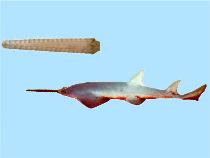
|
Pristis microdon Latham, 1794 Largetooth sawfish |

|
|
photo by
CSIRO |
| Family: | Pristidae (Sawfishes) | |||
| Max. size: | 700 cm TL (male/unsexed); max.weight: 600 kg; max. reported age: 30 years | |||
| Environment: | demersal; freshwater; brackish; marine; depth range 0 - 10 m, amphidromous | |||
| Distribution: | Indo-West Pacific: East Africa to New Guinea, north to the Philippines and Viet Nam, south to Australia. Also Atlantic and eastern Pacific if Pristis perotteti and Pristis zephyreus are synonymized with this species. The original description of Pristis microdon did not give a locality, but most authors have used the name Pristis microdon for the Indo-West Pacific sawfishes of this species group as contrasted from the Atlantic Pristis perotteti and the eastern Pacific Pristis zephyreus. | |||
| Diagnosis: |
Dorsal spines (total): 0-0; Anal spines: 0-0; Anal soft rays: 0-0. Diagnosis: A heavily-bodied sawfish with a short but massive saw which is broad-based, strongly tapering and with 14-22 very large teeth on each side; space between last 2 saw-teeth on sides less than 2 times space between first 2 teeth (Ref. 5578). Pectoral fins high and angular, 1st dorsal fin mostly in front of pelvic fins, and caudal fin with pronounced lower lobe (Ref. 5578). Description: Body shark-like; head and forebody depressed; caudal region compressed (Ref. 52193). Saw relatively short and broad, length 5 times width of base in mature specimens, 17-22 widely spaced teeth on either side (Ref. 52193). Mouth ventral, straight, numerous small teeth in bands; gill slits underneath, behind origin of pectoral fins (Ref. 52193). Pectoral fins large, triangular, extending onto the sides of the head; 2 dorsal fins, origin of first dorsal fin well in front of origin of pelvic fins; anal fin absent; caudal fin with distinct lower lobe (Ref. 52193). Colouration: Greenish, grey, olive or golden-brown above, dirty cream below (Ref. 5578, 52193). |
|||
| Biology: | Inhabits sandy or muddy bottoms of shallow coastal waters, estuaries, river mouths, and freshwater rivers and lakes. Usually found in turbid channels of large rivers over soft mud bottoms (Ref. 2847, 44894). Adults usually found in estuaries and young ascend into fresh water. Large adults can also be found in fresh water, but are rarely caught (Ref. 12693). Feeds on benthic animals and small schooling species. Ovoviviparous (Ref. 50449). The saw is used for grubbing and attacking prey as well as for defense. The saws sell as tourist souvenirs (Ref. 7248). Occasionally caught by demersal tangle net and trawl fisheries in the Arafura Sea; possibly extinct in parts of the Indo-Pacific; highly susceptible to gill nets. Utilized for its fins and meat (both of very high value), and skin and cartilage (Ref.58048). Attains 4.6 m total length (Ref. 52193). | |||
| IUCN Red List Status: | Not Evaluated (N.E.) Ref. (130435) | |||
| Threat to humans: | traumatogenic | |||